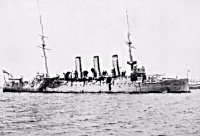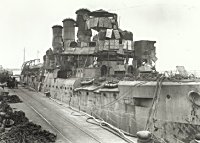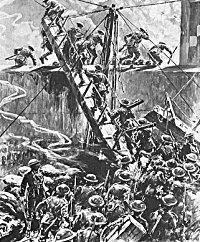Location
In the Memorial Garden beside the main path.

HMS Vindictive (1)

HMS Vindictive (2)

Action at Zeebrugge

USED BY
HMS VINDICTIVE
DURING ATTACK ON
ZEEBRUGGE 22-23 APRIL 1918.
Zeebrugge
Zeebrugge stands at the end of an eight mile long canal connecting Bruges with the North Sea. The canal was completed in 1908 with a large set of lock gates at the Zeebrugge end, maintaining the water level in the canal at low tide. A smaller shallower canal connects Bruges with the sea at Ostende.
There are no natural harbours on the coastline near Zeebrugge and so to protect the lock gates and the entrance to the canal from the storms of the North Sea, Belgian engineers built a harbour wall forty feet high and eighty yards wide stretching one and half miles out into the sea in a curving arc. At the time, this harbour wall (or Mole) created the world's largest man made harbour.
At the outbreak of the First World War in 1914, the German Army swept into Belgium quickly occupied Zeebrugge. They positioned hundreds of heavy guns along the coast line between Zeebrugge and Ostende and turned the Mole into a fortress housing a thousand troops
The reason for the Germans' great interest in Zeebrugge and the Bruges canal was the fierce submarine warfare they were waging against the British Isles. Ocean-going submarines which had been based on the North coast of Germany could now be moved to a new heavily fortified base at Bruges, cutting three hundred miles off their journey to the Atlantic to attack British shipping.
These submarine attacks continued throughout the war and by 1917 allied ships were being sunk at the rate of four hundred a month. Rationing had been imposed on the British people and the cabinet had been advised that England could be starved out of the War unless the submarine menace was brought under control.
An assault on Zeebrugge harbour had been discussed for some years, but the idea had been dismissed as too risky. Soon after his appointment as Admiral in command of the Dover Patrol, Roger Keyes resurrected and modified the plan and the Admiralty, keen for some action, gave him the go-ahead.
Keyes realised that trying to capture the port of Zeebrugge was far too ambitious, but a lightning attack with the aim of blocking the Bruges canal although dangerous was possible and would greatly reduce German submarine traffic in the Channel. The plan was developed under great secrecy under the code name 'Operation ZO' standing for Zeebrugge/Ostende.
Three old coal-burning cruisers - Thetis, Intrepid and Iphigenia - were to be filled with concrete and sailed across the Channel with the minimum crew, to be scuttled across the entrance to the canal. Because these ships would be sailing into the heavily defended Zeebrugge harbour within 100 yards of the German guns, a diversionary attack was to be launched to draw the enemy fire. Under cover of darkness and behind an immense smoke screen, a large raiding party would be landed on the Mole to engage the German troops stationed there and to destroy the heavy guns which covered the harbour and its approaches. This raiding party would be landed by a fourth redundant cruiser HMS Vindictive and withdrawn as soon as the blockships had manoeuvred into position and been scuttled.
To prevent the Germans reinforcing their troops on the Mole during the attack, the viaduct which connected the Mole to the mainland was to be destroyed. An old submarine filled with explosives was to sail under the viaduct and be blown up.
If all went to plan the crews from the blockships and from the destroyed submarine would be rescued by fast motor boats and ferried back to destroyers waiting outside the harbour.
A fleet having been assembled by Keyes sailed for the Belgian coast at 5pm on the afternoon of the 22nd April 1918. Seventy six vessels carrying over one thousand seven hundred men, formed up in three lines with Vindictive commanded by Capt Alfred Carpenter as the lead ship, towing the ferries Iris and Daffodil. These were followed by the blockships Thetis, Intrepid and Iphigenia.
On either side of the cruisers were scores of other vessels including submarines, rescue launches, smoke laying motor boats and the new destroyer HMS Warwick carrying Admiral Keyes.
As the fleet approached the Belgian coast, fast motor launches began laying a huge smoke screen in front of the Mole. Initially the wind blew in the right direction and the smoke completely hid the British ships. But at the last moment the wind changed and the smoke cleared. The Germans sent up a series of star shells which lit up the whole area. Heavy guns immediately opened fire on the Vindictive which by this time was less than 100 yards from the Mole. The Vindictive opened fire, but the German guns on the Mole had an easy target and their shell fire was devastating.
The officers on board Vindictive had ordered their men to shelter behind the specially constructed barricades. But they did not follow their own advise and stood unprotected on the open deck of the ship watching her approach to the Mole. As a result Captain Halahan, commanding the 200 volunteers from the Grand Fleet, was killed immediately by the opening rounds of the German defenders. Lt Cdr Chamberlain of the Neptune, commanding the men of 'B' Company, was also killed outright and Lt-Cdr Harrison was knocked unconscious with a broken jaw. The Marine commander Colonel Elliot was also killed. Vindictive arrived alongside the Mole at one minute past midnight on the 23rd April - St George's Day.
Having come alongside, Capt Carpenter in the Vindictive had difficulty in holding the ship's position and the cruiser started to drift away from the Mole before she could be secured. The Captain of the ferry boat Daffodil - Lt-Cdr Harold Campbell - quickly realised the situation and manoeuvred his vessel into a position from which he could push the cruiser back against the Mole with the nose of his own ship.
It proved impossible to secure Vindictive to the Mole using grappling irons and the Daffodil had to hold her in position throughout the raid. Despite the fact that two German shells exploded in her engine room the Daffodil's engineers managed to maintain full steam with her old coal-fired boilers. During this very difficult manoeuvre Harold Campbell was hit in the head by a piece of shrapnel and blinded in one eye, but he still remained at his post throughout the attack. Holding the Vindictive in position meant that the assault team on the Daffodil could not climb across the cruiser to get to the Mole and none of them were able to take part in the raid.
But the other Mersey ferry Iris did come alongside the Mole, a few hundred yards ahead of the Vindictive. She also had difficulty staying close to the harbour wall and was in danger of drifting away again. But as she heaved up and down in the swell Lt-Cdr Bradford jumped onto the parapet wall. He managed to secure the Iris to the Mole but as he did so, he was hit by a burst of machine gun fire. He fell into the sea between the ship and the Mole. Petty Officer Hallihan dived into the sea to rescue him, but they were both drowned.
The storming party's first objective was to silence the guns mounted on the end of the Mole, covering the entrance to the harbour. Having done this they were to hold their position, causing as much damage and diversion as they could, until the blockships were safely in position at the mouth of the canal. The assault troops had expected to land on the Mole behind the trenches which the Germans had built to defend their heavy guns at the end of the Mole. But the Vindictive's manoeuvres in trying to avoid the fierce German gun fire had sent her slightly off course and she came alongside a few hundred yards from her planned position. From this new position the British troops were faced with fighting their way back up the Mole, making a frontal attack on the German trenches which they had hoped to attack from the rear.
The raiding party soon discovered that ten of the Vindictive's twelve specially built gang planks had been smashed by gun fire or by crashing into the side of the Mole and to add to the confusion only one officer - Lt -Cdr Adams - was left to lead the attack.
Adams, seeing that half his men had been killed or wounded on board the Vindictive, quickly gathered together as many survivors as he could and led them across one of the two remaining gang planks. Adams was the first man onto the Mole and his hastily assembled team included Albert McKenzie and Able Seaman Childs, the two surviving members of their Lewis gun crew. Despite having to carrying two men's equipment - a Lewis gun plus 400 rounds of ammunition, Albert followed Adams across the gangplank and onto the Mole.
As they charged onto the Mole the only covering fire the Vindictive could provide came from a heavy machine gun mounted high up on her superstructure, since all her heavy guns were now below the top of the Mole. This machine gun was manned by Sgt Albert Finch and his position soon attracted all the German fire. Despite several direct hits on his position and being severely wounded Sgt Finch continued to man his machine gun.
Adams, with McKenzie at his side, led his party down the path which ran along the top of the parapet wall. Fifty yards past the stern of the Vindictive they came across a concrete observation post. There was an iron ladder next to this post and Adams sent some of his men down it onto the main deck of the Mole. McKenzie opened fire on German soldiers escaping from their living quarters to the safety of a destroyer moored on the far side of the Mole. Adams then led his team, which now included Lt-Cdr Brock, further along the path and they came under heavy fire from all directions. They tried to fight their way through the German positions to reach the heavily fortified end of the Mole, but many of them were killed or wounded in the attempt.
After the initial assault Adams and his men returned back along the Mole in search of reinforcements. In the meantime on board the Vindictive Lt-Cdr Harrison had regained consciousness and despite having a broken jaw he insisted on joining his men fighting on the Mole. He met Adams on his way back and helped organise the reinforcements. Harrison, who had played Rugby for England before the War, gathered together anyone who was still standing and led a fresh assault across the main deck of the Mole. McKenzie joined in the attack and opened fire on the German positions spraying the German positions with machine gun fire. After a short while a German round hit his Lewis gun, blowing it out of his hands. He threw the now useless gun and its remaining ammunition into the sea and took out his revolver. He shot several more German defenders before being wounded himself in the right foot and in the back.
The raiding party on the Mole had suffered heavy casualties and had been unable to achieve some of its objectives. But even though they had not been able to destroy the guns on the Mole, they had certainly drawn all their fire. Their attack had served its main purpose in that they had created an enormous diversion. Whilst they attacked the German defenders on the Mole, drawing the fire of every German gun within range, the blockships had sailed into the harbour and positioned themselves across the mouth of the Bruges canal. As they were scuttled and began to sink in position, their crews were being rescued by fast boat launches.
Above the sound of the battle on the Mole, the assault troops heard an enormous explosion. The British submarine C3, commanded by Lt. Richard Sandford, had managed to manoeuvre itself under the viaduct joining the Mole to the mainland and a few minutes after her crew had escaped, she exploded destroying the viaduct and preventing the German troops on the Mole from being reinforced. The assault team heard the Morse code 'K' sign sounding on the Daffodil's siren, indicating that the block ships were in position. The signal should have been given by the Vindictive but German shell fire had destroyed much of her superstructure, including her siren and most of her funnel.
Lt-Cdr Adams ordered his surviving men back to the Vindictive, and where possible they brought the wounded back with them. Adams went back and searched the parapet for survivors, but by now the whole area was being swept by vicious machine gun fire. Capt Carpenter on the Vindictive - waited for ten minutes after the withdrawal signal, whilst the wounded were carried back across the gang planks. Because of the swell some sailors fell into the sea between the harbour wall and the ship and were drowned. Able Seaman Childs helped the badly wounded Albert McKenzie back across the gangplank and down into the sick bay. At last Capt Carpenter gave the order for the Vindictive to pull away from the Mole. She had been along side for just 70 minutes.
As the Vindictive moved away from the Mole she left the protection of the harbour wall and once again came under intense German shelling. The Germans continued their bombardment of the ship, even using gas shells, until she disappeared behind a smoke screen laid by fast patrol boats moving in behind her.
The Winners of the Victoria Cross (Chosen by Ballot)
1. Captain Alfred Carpenter - Royal Navy
2. Captain Edward Bamford - Royal Marine Light Infantry
3. Lieutenant-Commander Arthur Harrison - Royal Navy (posthumous award)
4. Lieutenant-Commander George Bradford - Royal Navy (posthumous award)
5. Lieutenant Richard Sandford - Royal Navy
6. Lieutenant Percy Dean - Royal Navy Volunteer Reserve
7. Sergeant Norman Finch - Royal Marine Artillery
8. Able Seaman Albert McKenzie - Royal Navy (aged 19)
See the World Naval Ships Forum for a discussion of events at Zeebrugge.
Able Seaman Henry Bray who was killed aboard HMS Ajax is buried in Kingston Cemetery. An Unknown Stoker from HMS Vindictive is commemorated in St. Ann's Church in the Dockyard.
See also: the website dedicated to Able Seaman Albert McKenzie
